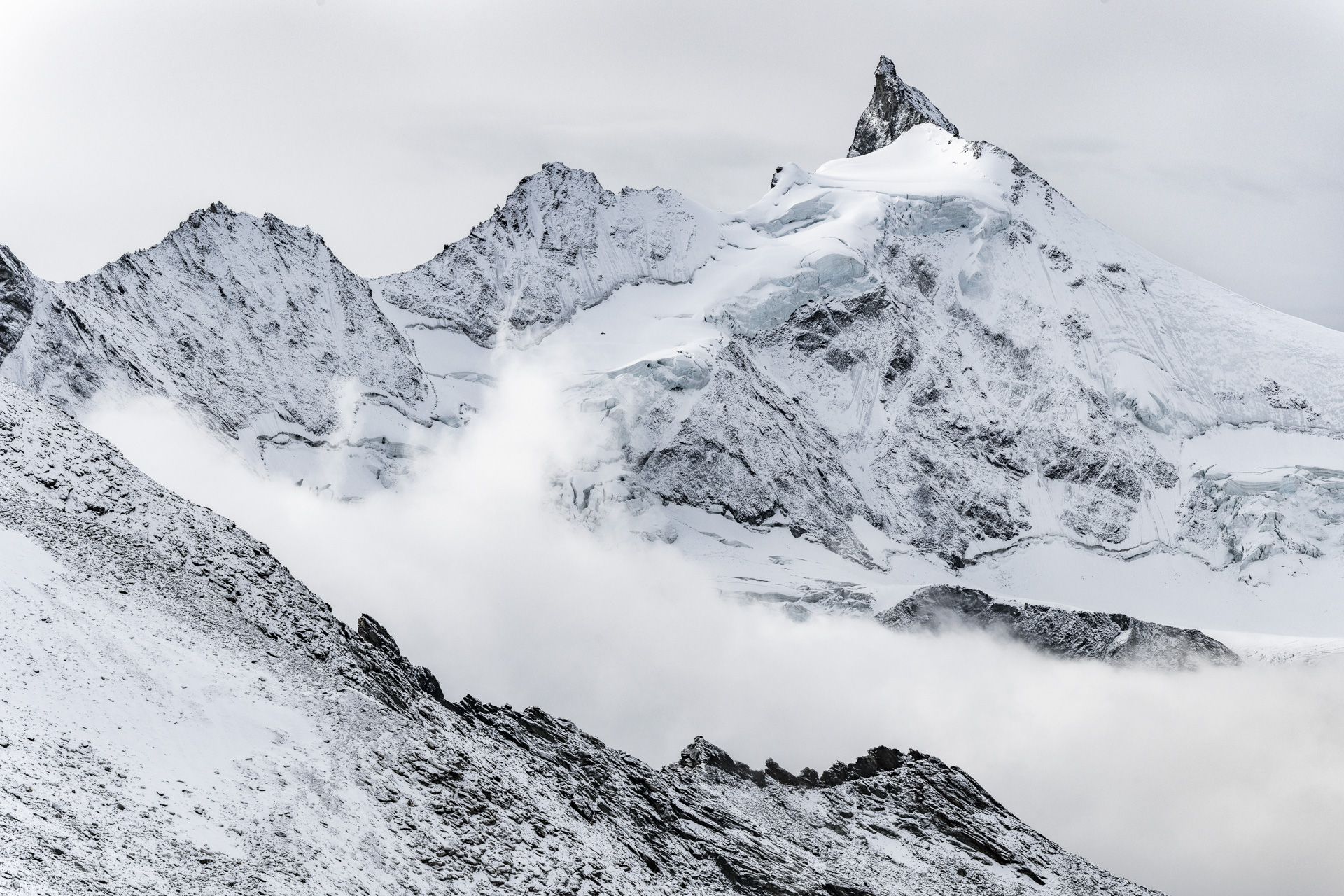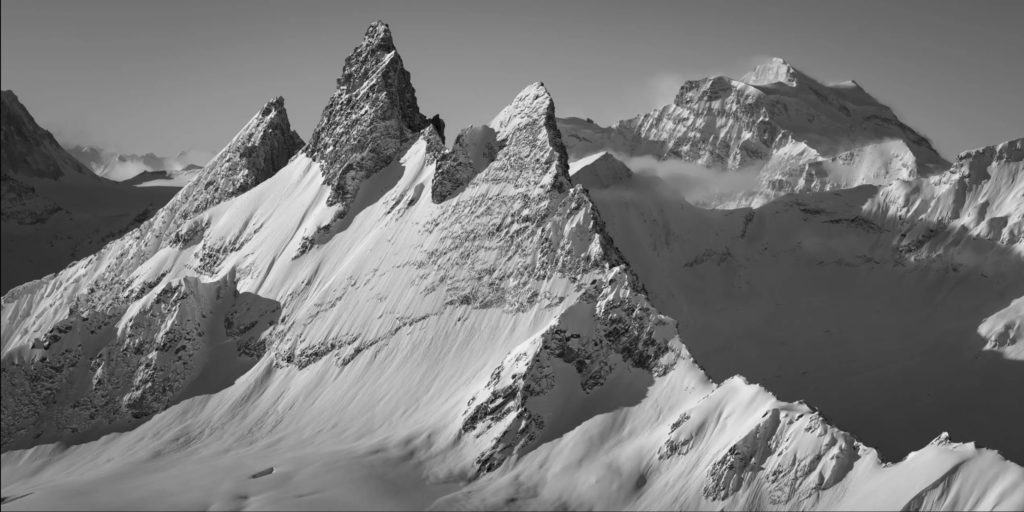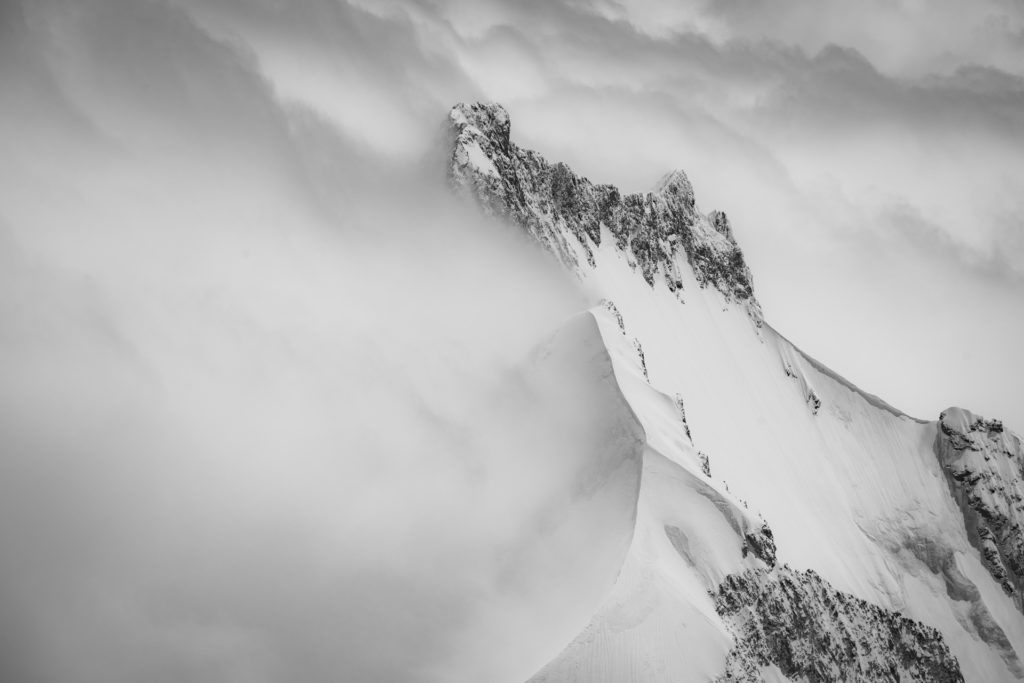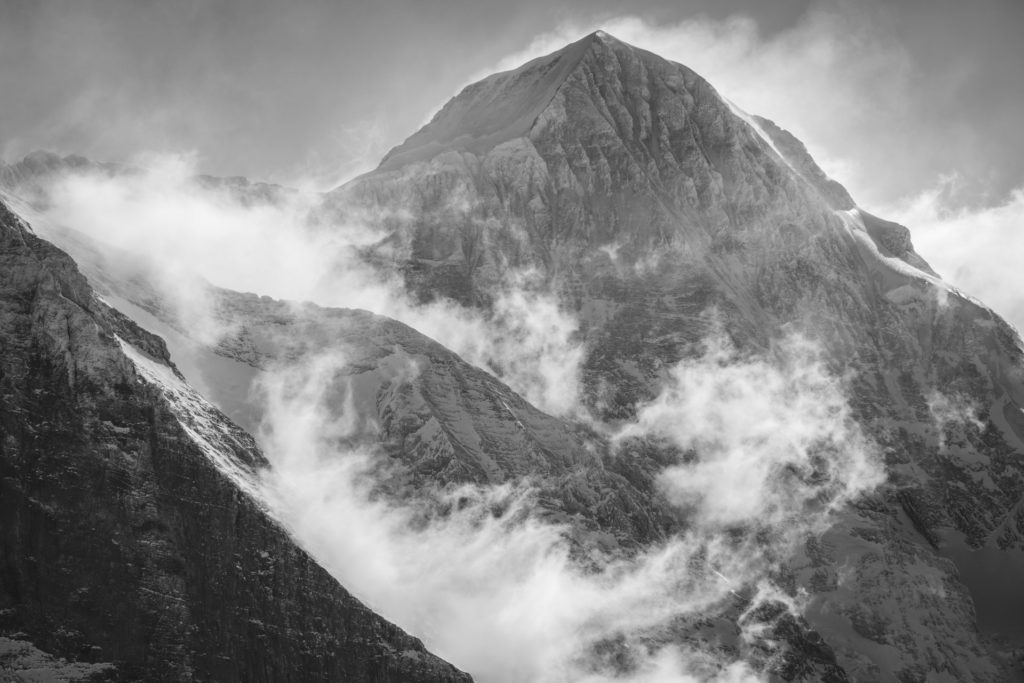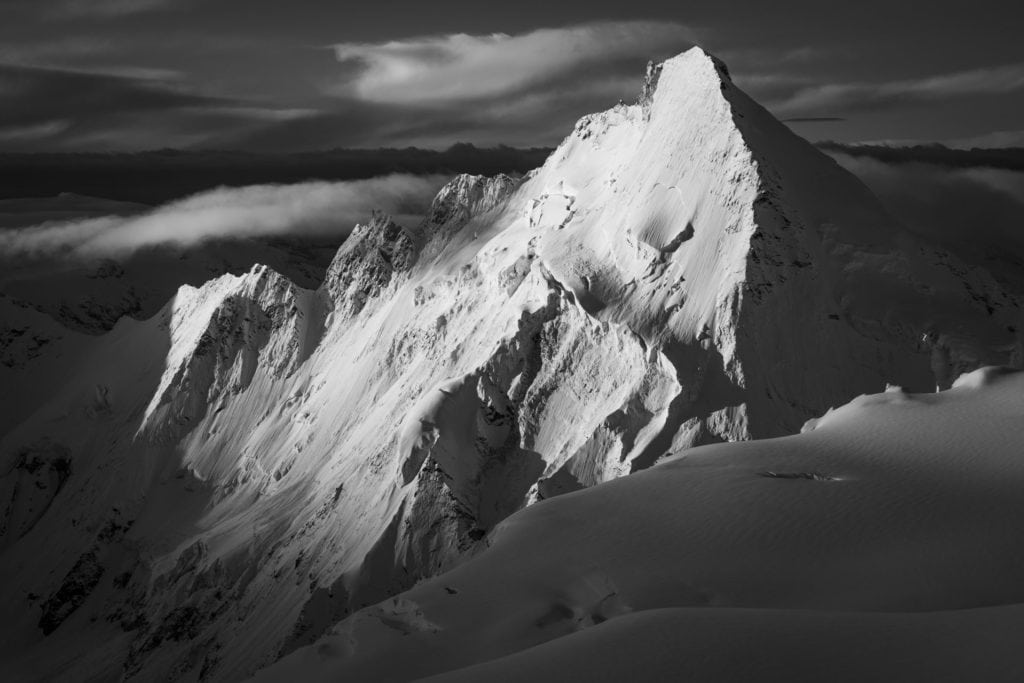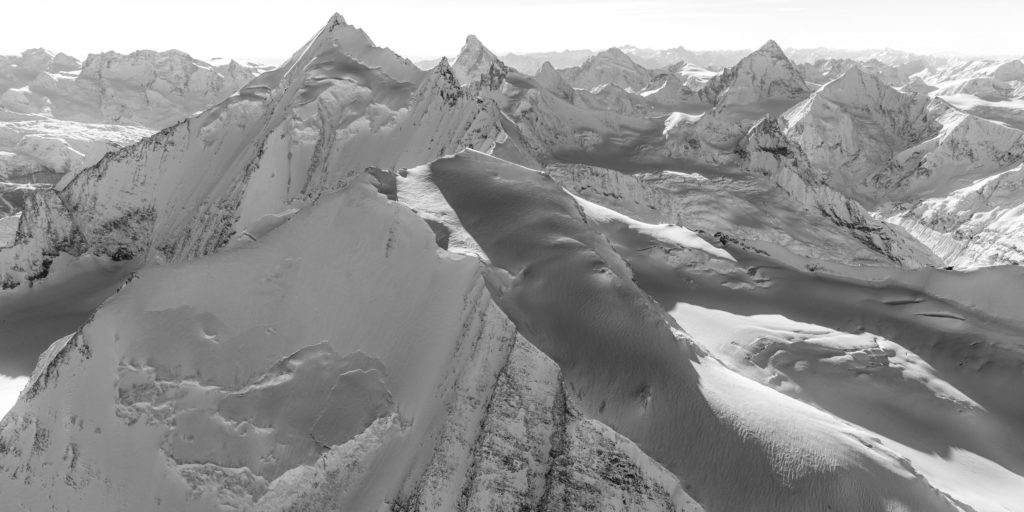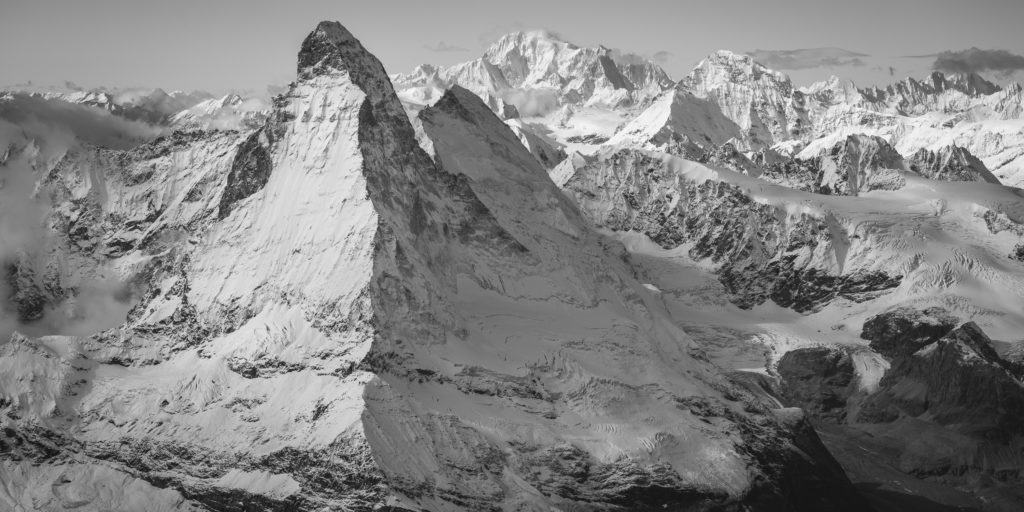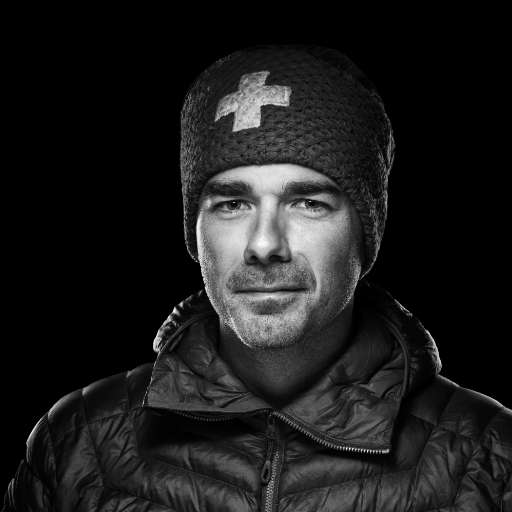From the heights of Zinal rises a mountain, a sylph-like goddess of exceptional stature whose silhouette unites dissonant waves. The Zinalrothorn seems to defy the laws of nature. How can such a slender peak become so imposing? How can its jagged rock withstand so much combat? The Zinalrothorn, thousand-year-old beacon of the Imperial Crown of Zinal, defies time and mankind to reach the sky at the summit of the Valais Alps.
Portrait of the Zinalrothorn: Flambeau de la Couronne impériale de Zinal
Like a lighthouse illuminated in the middle of the night, the Zinalrothorn brandishes its flamboyant tip towards the sky of the Valais Alps. An unshakeable, vigorous landmark, the mountain rises above Zinal, Täsch and Zermatt. A tutelary figure in an ocean of rock, the Zinalrothorn measures the beauty of an elusive nature on the border between val d’Anniviers and the Zermatt valley. At an altitude of 4221 metres, the echo of its voice joins those of Bishorn, Weisshorn,Obergabelhorn and Dent Blanche to sing the praises of the most remarkable peaks. The Imperial Crown of Zinal is a hymn to the grandeur of the Alps.
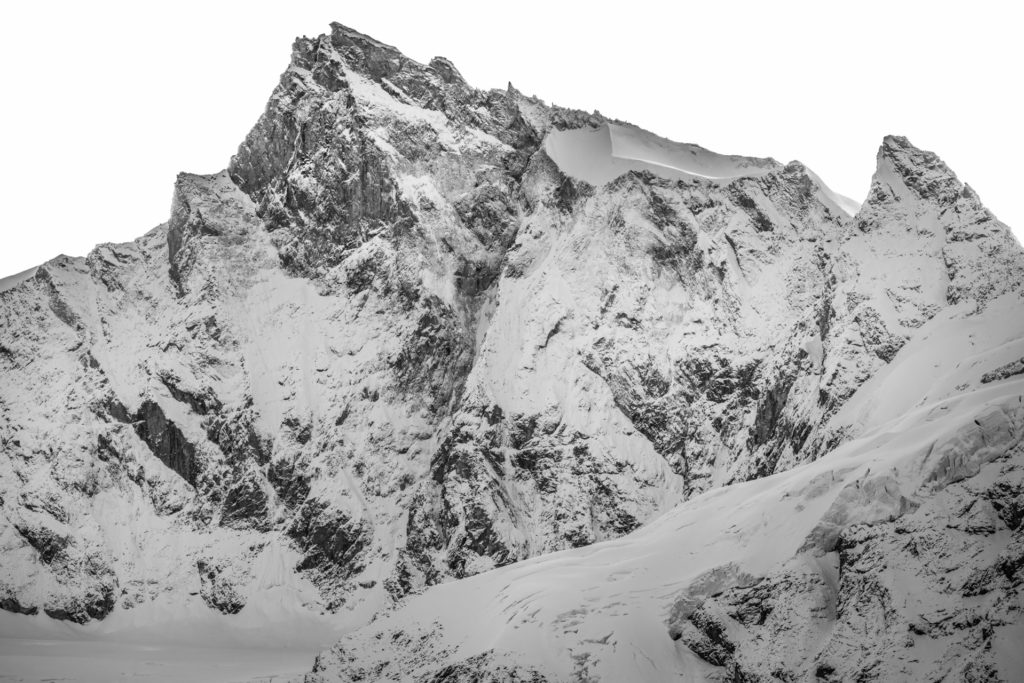
The ridges of the Zinalrothorn, which straighten as they reach for the sky, give the mountain its elegant, bold silhouette. A horn shaped by the winds in the age-old gneiss ofArolla, it offers those who try to reach its summit a hard, rough rock that invites adventure. Crossing its crests, you can climb the Sphinx, the Bosse or the Rasoir, the guardians of this legendary peak. These sharp bastions are a constant reminder of the mountain's throne, just as the thorns of a rose protect their queen from careless poets.
From Zermatt, the normal route to summit on the Zinalrothorn is via its south-east ridge, which is quite wide at the bottom. To the south-west, the Rothorngrat rises with its unyielding gendarmes. But if you want to tread its most beautiful ridge, you'll have to head north to the Zinalrothorn. Carefree and reckless, its northwest ridge is a mix of snow run and climbing route. Deciding to explore new horizons, it forks abruptly to the west at 4016 metres altitude. This forms the Épaule du Rothorn, which guides us from the Blanc de Moming onto the Arête du Blanc. At the foot of the Zinalrothorn lie fascinating, yet fragile rivers of ice: to the north the Moming glacier, to the east the Hohlichtgletscher, to the south the Triftgletscher and to the west the Mountet glacier. The Zinalrothorn, a rocky, flag-like creature, dominates this otherworldly landscape with the presence of the most prodigious summits in the Swiss Alps.
First ascent of the Zinalrothorn via its northwest ridge: In the Valais Alps
But, like its neighbors, the Zinalrothorn cannot escape human ambition. In 1863, mountaineer Stephen Winkworth, accompanied by his wife and two guides, decided to tackle the red horn of Zinal. They approached it via the Trift glacier, but their courageous attempt ended in failure. The mountain, displaying its might, valiantly resists the assaults of the most intrepid. Until its fate changed just one year later. On August 20, 1864, the Zinalrothorn gave way to the tenacity of Leslie Stephen and Florence Crauford Grove. With their guides, Melchior and Jakob Anderegg, they set off from Zinal at around 1 a.m. for a long run across the ice. From the Zinal glacier, they joined the Mountet glacier before finally reaching the Blanc ridge. A relentless, icy southerly wind penetrates their clothes and pierces their skin. They can no longer feel their hands, and their teeth chatter like the tragic percussion of a funeral oration. It's a tough fight and they're getting tired. There's still a long way to go, though, to the coveted summit .

To get there, they had to cross the Épaule du Rothorn and the northwest ridge of the Zinal giant. Melchior Anderegg leads the expedition. Icy rocks and sharp spurs are just some of the obstacles they have to overcome. Swept along by raging winds, they climb inexorably. It was as if the ridge had no end, as if summit took pleasure in retreating with every step they took. But the team hangs on. Beyond their suffering and despair, they continue their quest. Until the moment of resounding, historic victory arrived. At around 11 a.m., they finally reached summit , exhausted but happy, and thus completed the first ascent of the Zinalrothorn via its northern ridge. Their triumph was complete: the Rothorn had been conquered. The climbers, overlooking the Imperial Crown, contemplate the splendid panorama that stretches out before them. The way was now open for further odysseys. On July 22, 1872, Edward Robson Whitwell and Christian and Ulrich Lauener followed in the footsteps of our heroes, climbing the northwest ridge of the Zinalrothorn.
First ascent of the Zinalrothorn by its normal route: Prouesse at summit of the Imperial Crown
This year also marks the opening of the normal route from Zermatt. On September 5, 1872, George Augustus Passingham and Clinton Thomas Dent left the Zermatt valley at around 3am. They were accompanied by a porter and their respective guides, Ferdinand Imseng and Franz Andenmatten for the former, and Alexander Burgener for the latter. The party crossed the Rothorngletscher to reach the mountain's southeast ridge. They then join the Rothorngrat, which rises further to the west, heading for summit. While the guides fit out some difficult passages above the Gabel gap, the two climbers take a welcome break. Then, with the same fervor, the group climbs to the summit of the Zinalrothorn.
The speed of their ascent in no way diminishes the value of their feat. With their hearts full, they make their way back down to the valley. But the uncompromising mountain never gives the men the slightest respite. A boulder suddenly falls, testing the vigilance of our climbers. Fortunately, Franz Andenmatten's life-saving reflex deflects the projectile, which bounces off Ferdinand Imseng, who is not roped up. Franz Andenmatten is slightly injured, but the incident causes the team more fear than harm. It's a reminder of just how demanding the mountains are, requiring our full attention at all times.

The Zinalrothorn: a fascinating mountain in the Swiss Valais
1873 marked the start of the era of major traverses. On July 2, Thomas Cox, Frederick Gardiner, Peter Knubel and Josef Marie Lochmatter climbed the Zinalrothorn from the normal route to the north ridge. Next, man tackled the walls of the Zinal giant. On August 13, 1878, William Martin Conway, William Penhall and George Scriven, led by their guides Ferdinand Imseng and Peter and Matthias Truffer, set off from the Mountet hut to make the first ascent of the west face of the Zinalrothorn. A real feat of strength in the face of summit, a wall usually prone to rock falls.
One performance followed another, and with each passing record, the mountain came to accept man on its flanks. In August 1901, C.R. Gross and Rudolf Taugwalder reached summit via the southwest ridge of the Zinalrothorn, the magnificent Rothorngrat. On September 5, 1933, Kaspar Mooser, Émile-Robert Blanchet and Richard Pollinger achieved the as yet unachieved feat of climbing the mountain via the unique Kanzelgrat, its southeast ridge.
On August 3, 1939, the North Face of the Zinalrothorn was defeated forever. This wall of snow and ice rises 800 metres above the Moming glacier. An insurmountable obstacle of vertiginous proportions. But mountaineers Pierre Bonnant and Loulou Boulaz opened the route that would bear their name. From the glacier they reached the Épaule du Rothorn before continuing their ascent to the highest point of the Valais summit .
At summit on the Zinalrothorn: Challenges and records at the summit of the Alps
After exploring the faces of the Zinalrothorn, the man multiplied the routes leading to his summit. On August 6, 1945, André Roch, Robert Greloz and Ruedi Schmidt succeeded in opening a directional route on the mountain's east face. The area is unstable, however, and rock falls are commonplace.
On December 28, 1971, Paul Etter, Ueli Gantenbein, Andreas Scherrer and Ernst Scherrer made the first winter ascent of the Zinalrothorn's east face. Then came René Arnold and Michel Sherbaum, who made the first winter ascent of the southwest ridge on January 10, 1976.
New challenges are born. Fascinated by the Alps, man never ceases to surpass himself. He feels a compelling need to test his limits, and dreams of ever more remarkable feats. Out of a love of adventure, of course, but also to highlight the beauty of the high mountains and elevate their infinite power to the level of art. In contact with its rock and sumptuous snow, he opens up new and ever more challenging routes. But he also sometimes joins forces with the winds to reveal the soul of this exceptional natural environment. This is how, in 2013, Julian Zanker and Yannick Gundi made the first wingsuit flight from the heights of the Zinalrothorn down to the valleys.
From the Grand Mountet hut, the Rothornhütte or the Arpitettaz refuge, many mountaineering enthusiasts now set off to meet the Zinalrothorn. A beacon of rock buoyed by the brilliance of its eternal snows, the mountain is rigorous and hard to climb. But once you've reached summit, you'll have an unforgettable view of the most grandiose summits in the Valais Alps. In front of us, the Imperial Crown sparkles, while the Matterhorn and the Monte Rosa massif sculpt the horizon with their marvellous ridges.

